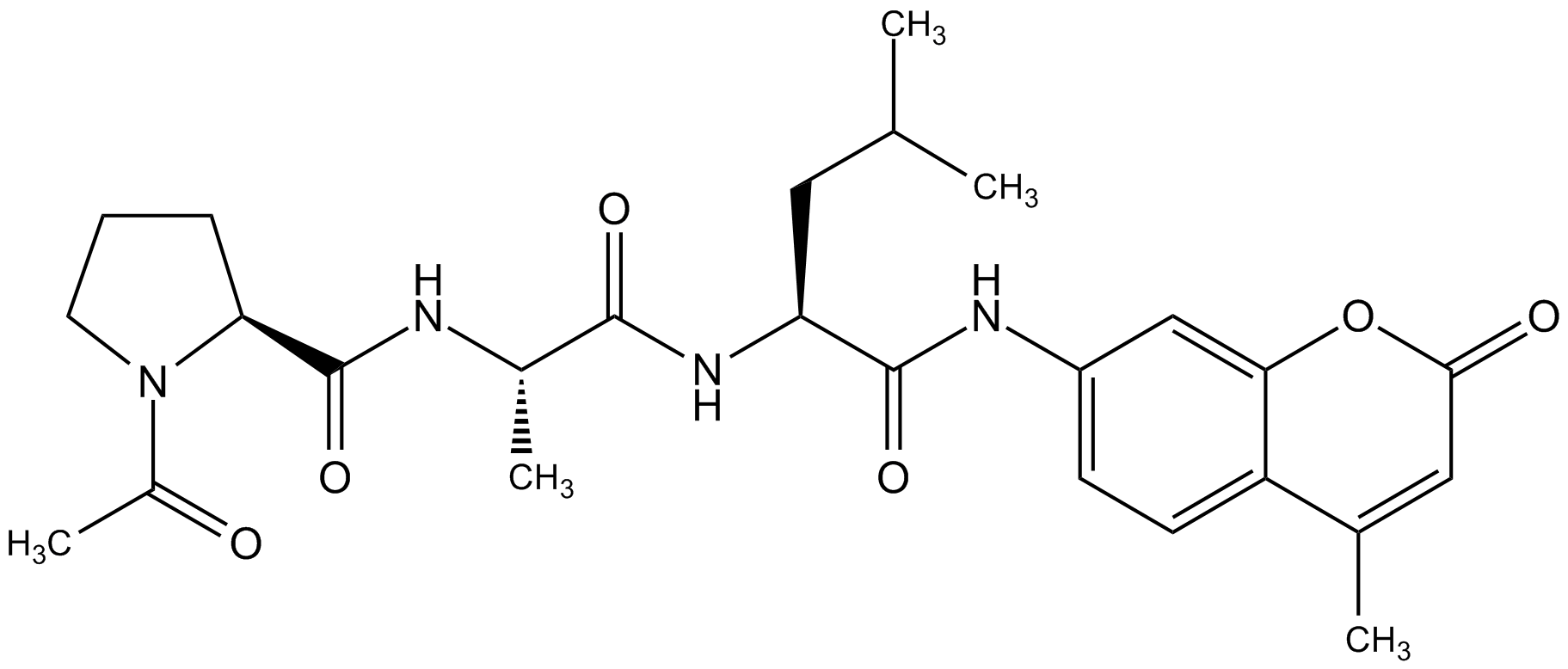Ac-Pro-Ala-Leu-AMC
| Code | Size | Price |
|---|
| AG-CP3-0036-M001 | 1 mg | £53.00 |
Quantity:
| AG-CP3-0036-M005 | 5 mg | £108.00 |
Quantity:
| AG-CP3-0036-M025 | 25 mg | £401.00 |
Quantity:
Prices exclude any Taxes / VAT
Overview
Regulatory Status: RUO
Shipping:
Ambient
Storage:
-20°C
Images
Further Information
Alternate Names/Synonyms:
Ac-PAL-AMC; Immunoproteasome Substrate
Appearance:
Lyophilized powder.
CAS:
1431362-79-6
EClass:
32160000
Form (Short):
liquid
Handling Advice:
Avoid freeze/thaw cycles.Protect from light.
InChi:
InChI=1S/C26H34N4O6/c1-14(2)11-20(25(34)28-18-8-9-19-15(3)12-23(32)36-22(19)13-18)29-24(33)16(4)27-26(35)21-7-6-10-30(21)17(5)31/h8-9,12-14,16,20-21H,6-7,10-11H2,1-5H3,(H,27,35)(H,28,34)(H,29,33)/t16-,20-,21-/m0/s1
InChiKey:
BWJPVHDZSJFFDM-NDXORKPFSA-N
Long Description:
Chemical. CAS: 1431362-79-6. Formula: C26H34N4O6. MW: 498.6. Ac-PAL-AMC is a fluorogenic peptide substrate for measuring caspase-like activity of the immunoproteasome. Hydrolysis of this substrate by the beta1i/LMP2-subunit of the immunoproteasome is monitored by observing fluorescence at an Excitation wavelength of 345nm and Emission at 445nm. This substrate is specific to the immunoproteasome and is not hydrolyzed efficiently by the constitutive proteasome.
Molecular Formula:
C26H34N4O6
Molecular Weight:
498.6
Other data:
Use: After preparing a stock solution in DMSO (>10mM) store product at -20°C to -80°C. It is recommended to make multiple aliquots after the first thaw to ensure best performance. Caspase-like activity can be measured using a typical working concentration range from 10-50µM.
Package Type:
Plastic Vial
Product Description:
Ac-PAL-AMC is a fluorogenic peptide substrate for measuring caspase-like activity of the immunoproteasome. Hydrolysis of this substrate by the beta1i/LMP2-subunit of the immunoproteasome is monitored by observing fluorescence at an Excitation wavelength of 345nm and Emission at 445nm. This substrate is specific to the immunoproteasome and is not hydrolyzed efficiently by the constitutive proteasome.
Purity:
>97%
Sequence:
Acetyl-Pro-Ala-Leu-7-amido-4-methylcoumarin
SMILES:
O=C(C)N1CCC[C@H]1C(N[C@@H](C)C(N[C@@H](CC(C)C)C(NC2 =CC=C(C(C)=CC(O3)=O)C3=C2)=O)=O)=O
Solubility Chemicals:
Soluble in DMSO.
Transportation:
Non-hazardous
UNSPSC Category:
Biochemical Reagents
UNSPSC Number:
12352200
Use & Stability:
Stable for at least 1 year after receipt when stored at -20°C.
References
Characterization of a new series of non-covalent proteasome inhibitors with exquisite potency and selectivity for the 20S beta5-subunit: C. Blackburn, et al.; Biochem. J. 430, 461 (2010) | PSMB9 codon 60 polymorphisms have no impact on the activity of the immunoproteasome catalytic subunit B1i expressed in multiple types of solid cancer: J.E. Park, et al.; PloS one 8, e73732 (2013) | Inhibitors of the immunoproteasome: current status and future directions: Z. Miller, et al.; Curr. Pharm. Des. 19, 4140 (2013) | Development and characterization of selective immunoproteasome inhibitors: C. Dubiella; Diss. Universitaet Muenchen (2015) | Cleavage specificity of Mycobacterium tuberculosis ClpP1P2 protease and identification of novel peptide substrates and boronate inhibitors with anti-bacterial activity: T. Akopian, et al.; J. Biol. Chem. 290, 11008 (2015) | Discovery of highly selective inhibitors of the immunoproteasome low molecular mass polypeptide 2 (LMP2) subunit: H.W.B. Johnson, et al.; ACS Med. Chem. Lett. 8, 413 (2017)



